#aloe excelsa
Explore tagged Tumblr posts
Text

Aloe excelsa | Zimbabwe aloe
Leaning Pine Arboretum, Cal Poly San Luis Obispo
9 notes
·
View notes
Text


Aloe excelsa
This is a tall-growing Aloe species from Zimbabwe, and our plant is just reaching a size where it has put out its first flower. The flowers are quite beautiful, but they will be much more so when it gets bigger and the inflorescence comes out with multiple branches. Aloes belong to the Asphodel Family, with many of them coming from Africa.
Brian
48 notes
·
View notes
Text
As 10 melhores plantas para purificar o ar da sua casa
News https://portal.esgagenda.com/as-10-melhores-plantas-para-purificar-o-ar-da-sua-casa/
As 10 melhores plantas para purificar o ar da sua casa
As plantas são aliadas valiosas na melhoria da qualidade do ar em ambientes fechados. Pesquisas indicam que algumas espécies vegetais são capazes de remover compostos orgânicos voláteis (COVs) do ar, como benzeno, formaldeído e amônia, que são comuns em produtos domésticos e materiais de construção. Além disso, as plantas contribuem para o aumento da umidade relativa do ar, absorvem dióxido de carbono e liberam oxigênio, promovendo um ambiente mais saudável e confortável.
Em espaços urbanos, onde a ventilação natural pode ser limitada, as plantas oferecem uma solução prática e estética para melhorar a qualidade do ar. Elas não apenas purificam o ar, mas também proporcionam um toque de natureza que pode ter efeitos positivos no bem-estar mental e emocional dos ocupantes.
Quais plantas são eficazes na purificação do ar?
Várias plantas são conhecidas por suas habilidades de purificação do ar. A seguir, estão algumas das mais eficazes e seus benefícios específicos:
Espada-de-são-jorge (Sansevieria trifasciata): Eficaz na remoção de benzeno e formaldeído. Ideal para quartos devido à sua capacidade de liberar oxigênio à noite.
Jiboia (Epipremnum aureum): Conhecida por remover formaldeído e monóxido de carbono, é perfeita para salas e cozinhas.
Lírio-da-paz (Spathiphyllum wallisii): Remove amônia e benzeno, sendo ideal para banheiros e escritórios.
Clorofito (Chlorophytum comosum): Excelente para eliminar monóxido de carbono, ideal para escritórios.
Palmeira-ráfia (Rhapis excelsa): Remove diversos poluentes, ideal para salas amplas.
Areca-bambu (Dypsis lutescens): Eficaz contra tolueno e benzeno, adequada para salas e varandas.
Antúrio (Anthurium andraeanum): Remove amônia, ideal para ambientes com pouca circulação de ar.
Ficus benjamina (Ficus benjamina): Elimina formaldeído e tolueno, ideal para escritórios bem iluminados.
Dracena marginata (Dracaena marginata): Remove benzeno e formaldeído, ideal para cantos de salas.
Aloe vera (Aloe barbadensis): Eficaz na remoção de benzeno, ideal para cozinhas.
Plantas (Créditos: depositphotos.com / AntonMatyukha)
Como posicionar as plantas para maximizar seus benefícios?
O posicionamento das plantas é crucial para otimizar seus efeitos purificadores. Aqui estão algumas sugestões de locais para colocá-las:
Quarto: Espada-de-são-jorge, lírio-da-paz
Sala: Areca, ficus, jiboia
Cozinha: Aloe vera, jiboia
Banheiro: Lírio-da-paz, antúrio
Escritório: Dracena, palmeira-ráfia
As plantas purificadoras são seguras para animais de estimação?
Embora muitas plantas purificadoras sejam benéficas para o ambiente, algumas podem ser tóxicas para animais de estimação. Plantas como jiboia, espada-de-são-jorge e lírio-da-paz devem ser evitadas em lares com pets. Alternativas seguras incluem clorofito, areca e palmeira-ráfia, que não representam riscos para cães e gatos.
Siga a gente no Google Notícias
0 notes
Text
Cây trồng trong phòng ngủ được ưa chuộng
Trong thời đại hiện nay, khi con người càng quan tâm đến sức khỏe và chất lượng không gian sống, việc trồng cây trong phòng ngủ đã trở thành một xu hướng phổ biến. Không chỉ giúp cải thiện chất lượng không khí, cây xanh còn mang lại sự thư giãn, tăng cường tinh thần và trang trí không gian sống. Vậy những loại cây nào thích hợp để trồng trong phòng ngủ? Bài viết này sẽ giới thiệu một số loại cây phổ biến và lợi ích mà chúng mang lại.

1. Cây lưỡi hổ (Sansevieria trifasciata)
Mô tả: Cây lưỡi hổ là một trong những loại cây dễ trồng nhất, không yêu cầu chăm sóc đặc biệt. Lá cây mọc thẳng đứng, có màu xanh đậm với các vệt trắng hoặc vàng.
Lợi ích: Cây lưỡi hổ có khả năng lọc không khí, loại bỏ các chất độc như formaldehyde, benzene, toluene. Ngoài ra, nó còn giúp cải thiện giấc ngủ bằng cách tăng cường lượng oxy vào ban đêm.

2. Cây nha đam (Aloe vera)
Mô tả: Cây nha đam có lá dày, mọng nước, thường có viền gai nhỏ. Đây là loại cây mọc nhanh và dễ chăm sóc.
Lợi ích: Nha đam có tác dụng lọc không khí, giúp loại bỏ formaldehyde và benzene. Ngoài ra, gel từ lá nha đam còn có tác dụng chữa lành vết thương, dưỡng da.
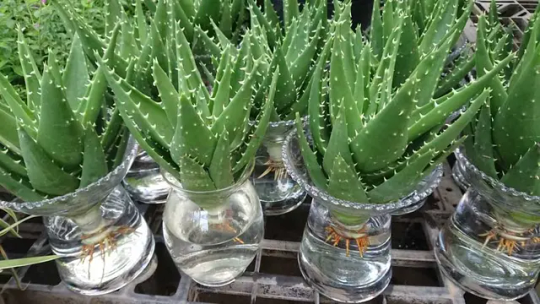
3. Cây lan ý (Spathiphyllum)
Mô tả: Cây lan ý có lá màu xanh bóng và hoa màu trắng tinh khôi. Đây là loại cây cảnh phổ biến trong việc trang trí nội thất.
Lợi ích: Lan ý có khả năng loại bỏ các chất độc như ammonia, benzene, formaldehyde, và trichloroethylene. Nó còn giúp cân bằng độ ẩm trong không khí, tạo cảm giác thoải mái và thư giãn.

4. Cây cau tiểu trâm (Chamaedorea elegans)
Mô tả: Cây cau tiểu trâm có lá mảnh, dài, màu xanh nhạt. Cây có thể cao lên đến 1-2 mét, tạo điểm nhấn cho không gian phòng ngủ.
Lợi ích: Cau tiểu trâm có khả năng lọc không khí, loại bỏ formaldehyde, benzene, carbon monoxide, và xylene. Ngoài ra, cây còn giúp tăng cường độ ẩm, rất tốt cho da và hệ hô hấp.
5. Cây dương xỉ (Nephrolepis exaltata)
Mô tả: Cây dương xỉ có lá mềm, mảnh, mọc xum xuê. Đây là loại cây rất dễ trồng và chăm sóc, thích hợp cho mọi không gian.
Lợi ích: Dương xỉ có khả năng loại bỏ các chất độc như formaldehyde, xylene, và toluene. Nó còn giúp cân bằng độ ẩm trong không khí, tạo cảm giác mát mẻ và dễ chịu.
6. Cây đa búp đỏ (Ficus elastica)
Mô tả: Cây đa búp đỏ có lá lớn, dày, bóng loáng với màu xanh đậm. Cây có thể cao lên đến 2-3 mét, rất thích hợp để trang trí trong phòng ngủ.
Lợi ích: Đa búp đỏ có khả năng lọc không khí, loại bỏ formaldehyde và các chất độc khác. Ngoài ra, cây còn giúp tạo điểm nhấn cho không gian, mang lại vẻ đẹp hiện đại và sang trọng.
7. Cây dây nhện (Chlorophytum comosum)
Mô tả: Cây dây nhện có lá dài, mảnh, thường mọc rủ xuống. Cây dễ trồng và phát triển nhanh, thích hợp cho người mới bắt đầu.
Lợi ích: Dây nhện có khả năng lọc không khí, loại bỏ formaldehyde và xylene. Ngoài ra, cây còn giúp tăng cường độ ẩm, tạo cảm giác thoải mái và dễ chịu.

8. Cây cọ lá tre (Rhapis excelsa)
Mô tả: Cây cọ lá tre có lá hình quạt, màu xanh đậm, mọc thành từng chùm. Cây có thể cao lên đến 3-4 mét, tạo điểm nhấn cho không gian phòng ngủ.
Lợi ích: Cọ lá tre có khả năng lọc không khí, loại bỏ formaldehyde, ammonia, và benzene. Ngoài ra, cây còn giúp tăng cường độ ẩm, rất tốt cho da và hệ hô hấp.
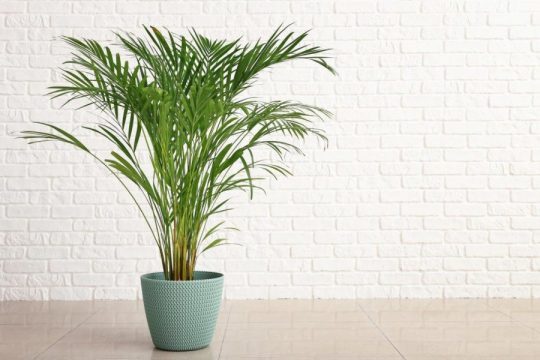
9. Cây bạch mã hoàng tử (Aglaonema)
Mô tả: Cây bạch mã hoàng tử có lá lớn, màu xanh đậm với các vệt trắng. Cây dễ trồng và chăm sóc, thích hợp cho mọi không gian.
Lợi ích: Bạch mã hoàng tử có khả năng lọc không khí, loại bỏ formaldehyde và benzene. Ngoài ra, cây còn giúp tăng cường độ ẩm, tạo cảm giác mát mẻ và dễ chịu.
10. Cây nhện lòng đèn (Chlorophytum comosum)
Mô tả: Cây nhện lòng đèn có lá dài, mảnh, thường mọc rủ xuống. Cây dễ trồng và phát triển nhanh, thích hợp cho người mới bắt đầu.
Lợi ích: Nhện lòng đèn có khả năng lọc không khí, loại bỏ formaldehyde và xylene. Ngoài ra, cây còn giúp tăng cường độ ẩm, tạo cảm giác thoải mái và dễ chịu.
Kết luận:
Việc trồng cây trong phòng ngủ không chỉ giúp cải thiện chất lượng không khí mà còn mang lại nhiều lợi ích khác nhau cho sức khỏe và tinh thần. Mỗi loại cây đều có những đặc điểm và công dụng riêng, phù hợp với từng nhu cầu và sở thích cá nhân. Hãy lựa chọn một hoặc nhiều loại cây phù hợp để trang trí phòng ngủ của bạn, biến không gian trở nên xanh mát và dễ chịu hơn.
0 notes
Text
50 Air purifying plants masterlist!
Many plants do "purify" the air. Scientifically, though, their air purifying powers makes little difference to the air we breathe because they're not effective enough. Myth busted, unfortunately.
“The scientific literature shows that indoor houseplants—as would be typically implemented in a person’s home—do very little to clean the air,” said one Elliott Gall, a prof at Portland State University who specializes in the “physics and chemistry of indoor air quality.”
This all [...] stems back to an eighties NASA study that sought to ascertain whether houseplants could filter out air pollutants known as “volatile organic compounds” or VOCs. Pretty much everything that has any scent to it releases VOCs, from the obvious (cigarettes, cleaners, disinfectants) to the less so (craft supplies, printers, shampoo).
The study, conducted by Bill Wolverton and published in 1989, concluded that houseplants could absorb VOCs.
But Waring refutes Wolverton’s findings. Though he and his colleagues found that some plants do filter VOCs better than others, none of them filter pollutants at such a manic rate that a few houseplants here and there will actually make a difference in cleaning the air in your home. In a small ten-by-ten-by-eight-foot office, Waring told the Atlantic, you would need “to put 1,000 plants in that office to have the same air-cleaning capacity of just changing over the air once per hour, which is the typical air-exchange rate in an office ventilation system,” he said. (source: Coveteur, 2019)
Don't care? Me neither! Here are the 50 plants NASA found do purify the air a teensy insignificant amount:
(psst: use ctrl + F or cmd + F and search for the plant name if you're wondering about a specific plant!)
Aloe Vera - Aloe barbadensis Anthurium - Anthurium andraeanum Areca Palm - Chrysalidocarpus lutescens Bamboo Palm - Chamaedorea seifrizii Boston Fern - Nephrolepis exaltata "Bostoniensis" Chinese Evergreen - Aglaonema Christmas Cactus - Schlumbergera buckleyi Corn Plant - Dracaena fragrans Croton - Codiaeum variegatum pictum Cyclamen - Cyclamen persicum Dendrobium - Orchid Dendrobium Dracaena "Janet Craig" - Dracaena deremensis Dracaena "Warneckei" - Dracaena dermensis Dragon Tree - Dracaena marginata Dumb Cane - Dieffenbachia "Exotica Compacta" Dumb Cane - Dieffenbachia camilla Dwarf Azalea - Rhododendron simsii Dwarf Banana - Musa cavendishii Dwarf Date Palm - Phoenix roebelenii Easter Cactus - Schlumbergera gaertneri Elephant Ear Philodendron - Philodendron domesticum / tuxla English Ivy - Hedera helix Ficus "Alii" - Ficus macleilandii Gerbera Daisy - Gerbera jamesonii Golden Pothos / Devil's Ivy - Epipremnum aureum Heart-Leaf Philodendron - Philodendron hederaceum Kalanchoe - Kalanchoe blossfeldiana Kimberly Queen Fern - Nephrolepis obliterata King of Hearts - Homalomena wallisii Lacy Tree Philodendron - Thaumatophyllum bipinnatifidum Lady Palm - Rhapis excelsa Lily Turf - Liriope spicata Moth Orchid - Phalaenopsis Norfolk Island Pine - Araucaria heterophylla Oakleaf Ivy / Grape Ivy - Cissus rhombifolia Parlor Palm - Chamaedorea elegans Peace Lily - Spathiphyllum Peacock Plant - Calathea makoyana Poinsettia - Euphorbia pulcherrima Pot Mum - Chrysanthemum morifolium Prayer Plant - Maranta leuconeura Red Emerald Philodendron - Philodendron erubescens Rubber Plant - Ficus robusta Schefflera / Umbrella Plant - Schefflera arboricola Snake plant / Mother-in-Law's Tongue - Sansevieria trifasciata "laurentii" Spider Plant - Chlorophytum comosum Syngonium - Syngonium podophyllum Urn Plant - Aechmea fasciata Wax Begonia - Begonia Semperflorens Weeping Fig - Ficus benjamina
Source: NASA Spinoff
18 notes
·
View notes
Photo
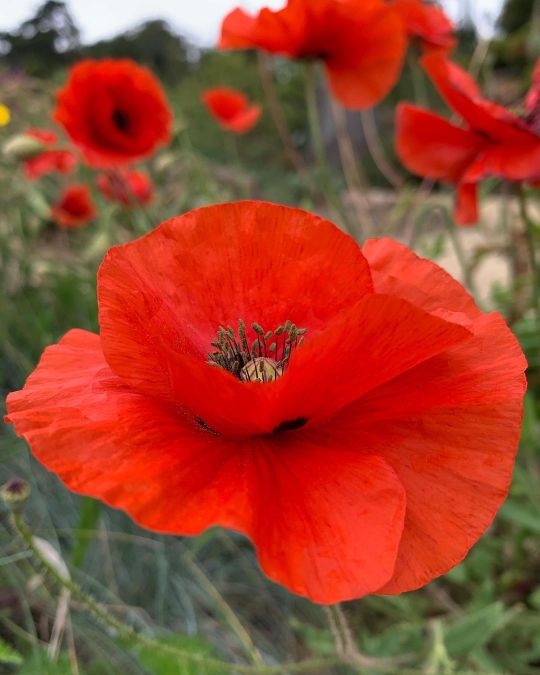
Happy #pride🌈 , y’all! ❤️ Papaver rhoeas 🧡 Isoplexis canariensis Lobelia excelsa 💛 Aloe striatula Grindelia hirsutula 💚 Axis lawn edge (Cornus capitata, Eutrochium purpureum, Hydrangea aspera, Gunnera tinctoria) 💙 Puya alpestris 💜 Passiflora violacea 'Eynsford Gem' Echium pininana Iris ensata 🌈 #sfbotanicalgarden #pridemonth #pride #pride2021 (at San Francisco Botanical Garden) https://www.instagram.com/p/CQo6DVMAxE7/?utm_medium=tumblr
2 notes
·
View notes
Photo

Prendete la vita con leggerezza, che leggerezza non è superficialità, ma planare sulle cose dall'alto, non avere macigni sul cuore. [Italo Calvino - Lezioni americane]
@coffea-excelsa
#caffè#tazzina di caffe#pausa caffè#coffee#coffetime#coffee lover#coffiecup#profumo di caffè#caffetteria#caffeina#relax#leggerezza
11 notes
·
View notes
Text
Natural air purifier
1,Aloe – pot of aloe vera is equivalent to nine biological air cleaner
Potted aloe vera with an air purifier reputation experts. Pot of aloe vera is equivalent to nine biological air cleaners, can absorb formaldehyde, carbon monoxide, carbon dioxide, sulfur dioxide and other harmful substances. Especially formaldehyde absorption particularly strong. Experiments show that: In four hours light conditions, a pot of aloe vera can eliminate one square meter of air in 90% formaldehyde. 2, Dripping Guanyin – clear the air of dust Dripping Guanyin scavenging air dust effect. However, it is worth noting: dripping Guanyin stem poisonous white sap, drops of water is also toxic. Inadvertently touching or eating its juice, can cause throat and mouth discomfort, stomach burning sensation. Special attention should be eating to prevent young children. It should be noted that in place of the reach of children. 3, Rubber tree – the elimination of hazardous substances rounder Rubber tree is a versatile eliminate hazardous substances. In the air of carbon monoxide, carbon dioxide, hydrogen fluoride and other harmful gases have a certain resistance. Rubber trees but also to eliminate particulate matter pollution, indoor dust can play an effective role in the stagnation of dust. 4,Asparagus – destroy bacteria and virus protection umbrella Aromatic plant asparagus contain antibacterial ingredients that can clear the air of bacteria and viruses, with health care function, so releasing the smell of asparagus has bactericidal activity of beneficial bacteria. In addition, the asparagus has high medicinal value. Digging its fleshy roots washed above the dust dirt, dried or fresh-use spare; leafy branches used with mining, have lungs cough, cooling blood detoxification. 5, Maidenhair fern – the most effective biological “purification” Maidenhair fern can absorb about 20 micrograms of formaldehyde per hour, it is considered one of the biological “purification” of the most effective. Workers day and paint, paint to deal with, or there like smoking, should be placed at least a pot of ferns in the workplace. In addition, it can inhibit the release of computer monitors and printers in the xylene and toluene, so for the whole day in the office work white-collar office workers, place pots of ferns at the desk is the best and simple. 6, Zongzhu – remove heavy metals pollution and carbon dioxide Zongzhu functions like Monstera. Belong to the same large-leaved ornamental excelsa plant can absorb more than 80% of harmful gases, purify the air. Zongzhu while also eliminating the ability of heavy metal pollution and sulfur dioxide pollution has a certain role in the resistance. Of course, as the huge leaf foliage plants, their biggest feature is the general plant can not match the digest carbon dioxide and produce oxygen function. 7, Spider plants – air can absorb 95% of the carbon monoxide and 85% formaldehyde Spider plants to carry out photosynthesis in the faint light, absorb carbon dioxide and release oxygen, and air can absorb toxic and harmful gases. Chlorophytum pot 8-10 square meters room on the equivalent of an air purifier. Usually in the room raised 1 to 2 pots Chlorophytum can release oxygen for 24 hours, while absorbing the air of formaldehyde, styrene, carbon monoxide, carbon dioxide and other carcinogens. 8, Lucky bamboo – bedroom for healthy plants Lucky Bamboo can be improved without regular window ventilation room air quality, regulate indoor humidity function. Especially in the bedroom, Lucky Bamboo can effectively absorb emissions, reduce the radiation of electronic products, so that the privacy

Olansi K15C3 Air Purifier
of the bedroom environment improved. Lucky Bamboo while the color was dark green or green to help people’s physical and mental pleasure.
Guangzhou Olansi Healthcare Co., Ltd is a professional air purifier,water purifier and hydrogen water generator manufacturer factory from china supplier.
Source: Natural air purifier
0 notes
Text

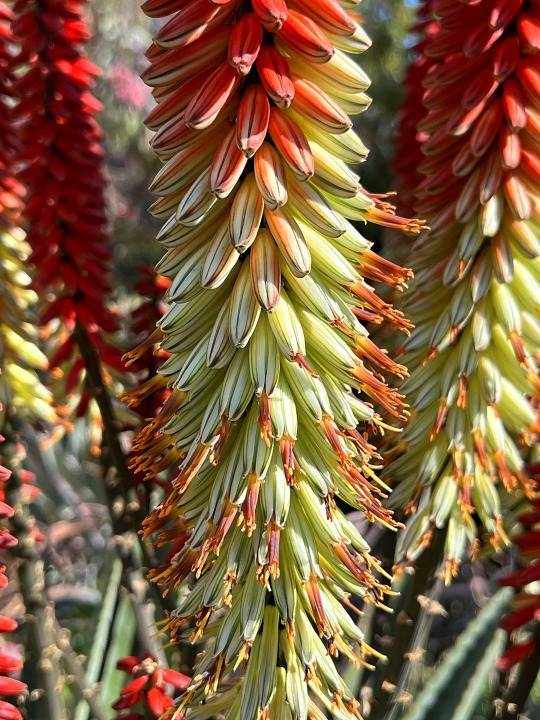
Aloe excelsa × petricola
It is always gratifying when a hybrid turns out the way you wanted it to, and this one is a good example. I was looking for a plant with the large size and many-branched inflorescence of Aloe excelsa, but with the extra-long bi-colored racemes of Aloe petricola - and this is just what I got. Aloe excelsa is mainly from Zimbabwe (though it does occur in the northeastern corner of South Africa as well), and Aloe petricola is endemic to South Africa.
-Brian
53 notes
·
View notes
Photo
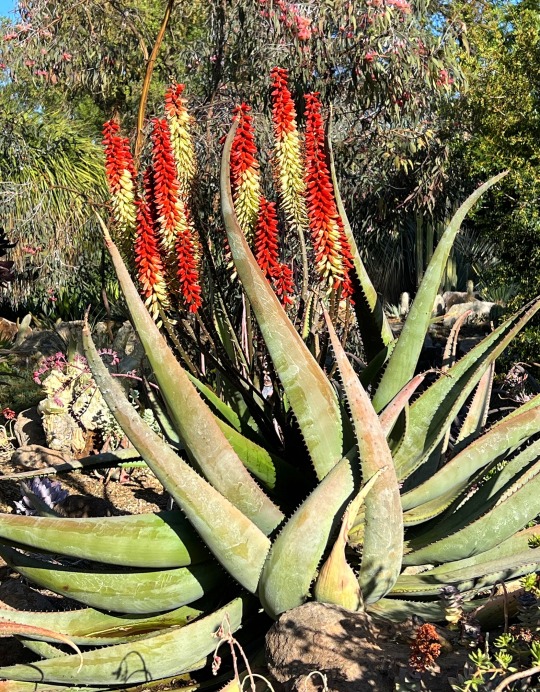
Aloe excelsa × petricola
When I made this hybrid about 25 years ago, I had the idea that it would be nice to combine the striking red-and-white flower spikes of Aloe petricola with the larger size and many floral branches of Aloe excelsa. It has certainly done what I wanted it to do, but I don’t yet know if it will eventually grow a tall stem like Aloe excelsa, or if it will remain stemless.
-Brian
53 notes
·
View notes
Photo
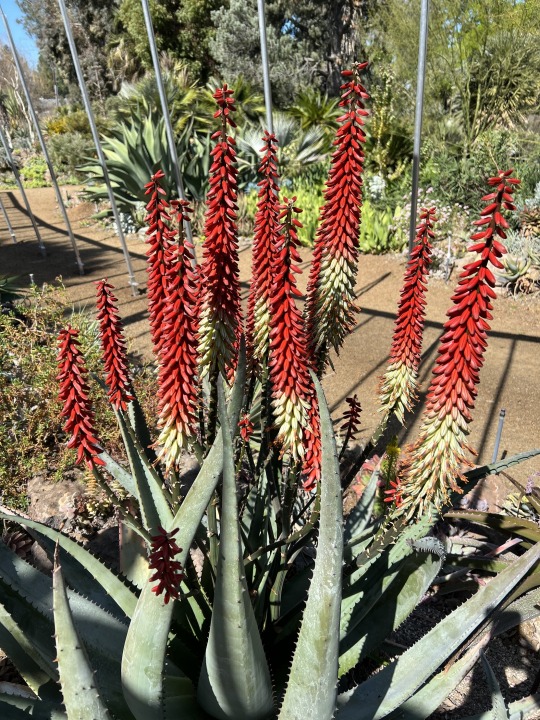
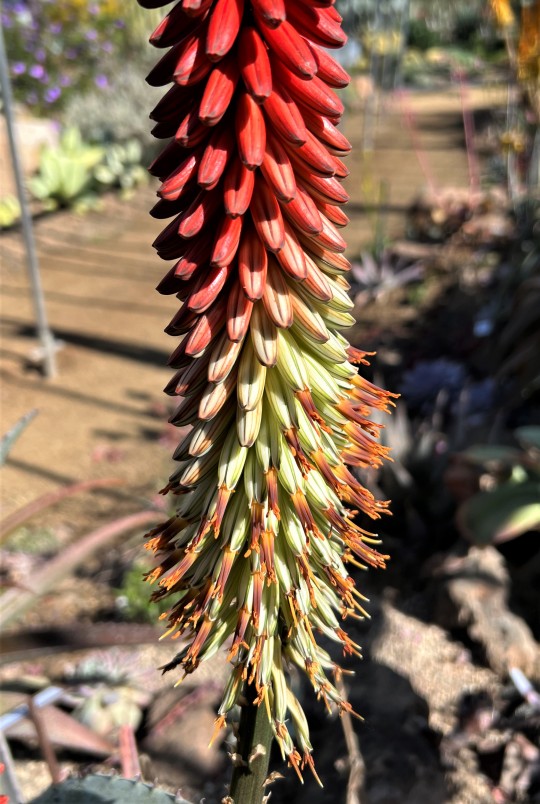
Aloe excelsa × petricola
Aloe petricola is a stemless species from northeastern South Africa, while Aloe excelsa comes from farther north (mainly in Zimbabwe) and has a trunk. The hybrid takes after A. petricola in being stemless and in the striking red-and-white elongated clusters of flowers, but it has inherited the many-branched inflorescence of A. excelsa, which makes for a very showy plant indeed.
-Brian
31 notes
·
View notes
Photo


Aloe aculeata
This aloe is native to the northeast of South Africa and northward into Zimbabwe, and it is notable for its prickly leaf surfaces and spires of densely-packed flowers. Unlike other aloes with prickly leaves, like Aloe marlothii, Aloe ferox and Aloe excelsa, it does not form a trunk.
-Brian
10 notes
·
View notes
Photo


Aloe excelsa x petricola
This plant is a hybrid I made quite a few years ago, and it is having a very good year. Since Aloe excelsa develops a trunk, while A. petricola does not, it remains to be seen how tall this plant will eventually get. Aloe excelsa is mostly found in Zimbabwe, while A. petricola comes from South Africa.
-Brian
86 notes
·
View notes
Photo


Gasteria huttoniae
Gasteria is a much smaller genus related to the aloes, with the “gaster” (Latin for stomach) in its name referring to the pot-bellied flowers. All of them are native to southern Africa, with most occurring in a strip along the southern edge of the continent. The plant pictured was named many years ago as Gasteria huttoniae, but for some time it has been considered a form of G. excelsa. However, its leaves are much shorter (more triangular and less sword-like than its giant cousin), and its inflorescence has fewer branches. Also, its leaf edges are slightly serrated, and are sometimes sharp enough to draw blood if handled carelessly. Thus, there is a case to be made for resurrecting the old name G. huttoniae for these plants, which occur along the Kei and Tsomo rivers and their tributaries, in South Africa’s Eastern Cape Province. The longer-leaved typical Gasteria excelsa is found in drainages farther to the southwest, along the Fish River and smaller nearby river drainages.
-Brian
11 notes
·
View notes
Text
Natural air purifier you never know
1,Aloe – pot of aloe vera is equivalent to nine biological air cleaner
Potted aloe vera with an air purifier reputation experts. Pot of aloe vera is equivalent to nine biological air cleaners, can absorb formaldehyde, carbon monoxide, carbon dioxide, sulfur dioxide and other harmful substances. Especially formaldehyde absorption particularly strong. Experiments show that: In four hours light conditions, a pot of aloe vera can eliminate one square meter of air in 90% formaldehyde. 2, Dripping Guanyin – clear the air of dust Dripping Guanyin scavenging air dust effect. However, it is worth noting: dripping Guanyin stem poisonous white sap, drops of water is also toxic. Inadvertently touching or eating its juice, can cause throat and mouth discomfort, stomach burning sensation. Special attention should be eating to prevent young children. It should be noted that in place of the reach of children. 3, Rubber tree – the elimination of hazardous substances rounder Rubber tree is a versatile eliminate hazardous substances. In the air of carbon monoxide, carbon dioxide, hydrogen fluoride and other harmful gases have a certain resistance. Rubber trees but also to eliminate particulate matter pollution, indoor dust can play an effective role in the stagnation of dust. 4,Asparagus – destroy bacteria and virus protection umbrella Aromatic plant asparagus contain antibacterial ingredients that can clear the air of bacteria and viruses, with health care function, so releasing the smell of asparagus has bactericidal activity of beneficial bacteria. In addition, the asparagus has high medicinal value. Digging its fleshy roots washed above the dust dirt, dried or fresh-use spare; leafy branches used with mining, have lungs cough, cooling blood detoxification. 5, Maidenhair fern – the most effective biological “purification” Maidenhair fern can absorb about 20 micrograms of formaldehyde per hour, it is considered one of the biological “purification” of the most effective. Workers day and paint, paint to deal with, or there like smoking, should be placed at least a pot of ferns in the workplace. In addition, it can inhibit the release of computer monitors and printers in the xylene and toluene, so for the whole day in the office work white-collar office workers, place pots of ferns at the desk is the best and simple. 6, Zongzhu – remove heavy metals pollution and carbon dioxide Zongzhu functions like Monstera. Belong to the same large-leaved ornamental excelsa plant can absorb more than 80% of harmful gases, purify the air. Zongzhu while also eliminating the ability of heavy metal pollution and sulfur dioxide pollution has a certain role in the resistance. Of course, as the huge leaf foliage plants, their biggest feature is the general plant can not match the digest carbon dioxide and produce oxygen function. 7, Spider plants – air can absorb 95% of the carbon monoxide and 85% formaldehyde Spider plants to carry out photosynthesis in the faint light, absorb carbon dioxide and release oxygen, and air can absorb toxic and harmful gases. Chlorophytum pot 8-10 square meters room on the equivalent of an air purifier. Usually in the room raised 1 to 2 pots Chlorophytum can release oxygen for 24 hours, while absorbing the air of formaldehyde, styrene, carbon monoxide, carbon dioxide and other carcinogens. 8, Lucky bamboo – bedroom for healthy plants Lucky Bamboo can be improved without regular window ventilation room air quality, regulate indoor humidity function. Especially in the bedroom, Lucky Bamboo can effectively absorb emissions, reduce the radiation of electronic products, so that the privacy
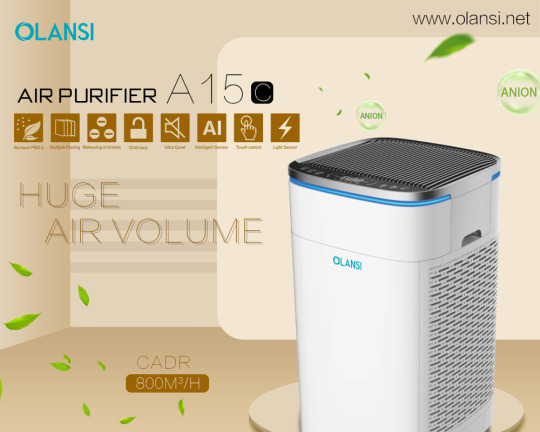
Olansi K15C3 Air Purifier
of the bedroom environment improved. Lucky Bamboo while the color was dark green or green to help people’s physical and mental pleasure.
Guangzhou Olansi Healthcare Co., Ltd is a professional air purifier,water purifier and hydrogen water generator manufacturer factory from china supplier.
Source: Natural air purifier
0 notes
